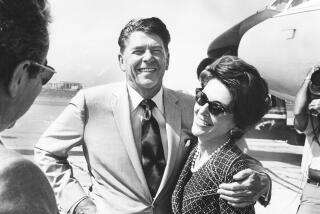Breaking into the ‘90s. A New World in Time. Walls fall, debts rise, politicians thrive, environments suffer-a look over the shoulder and over the horizon. : Political Wars, Initiatives Shaped 1980s State Power
The late Jess Unruh once summarized state politics: “There are only two significant power positions--the governor and the Speaker of the Assembly.” The impact of the 1980 Speakership fight plus the 1982 gubernatorial election defined a decade of politics--and Californians will experience the consequences well into the 1990s.
The 1980 Assembly races became a precedent--and a bidding war--after Howard L. Berman of Panorama City, then majority leader, challenged then-Speaker Leo T. McCarthy of San Francisco. McCarthy had angered many Assembly Democrats by raising money for a possible statewide race rather than for legislative contests. Campaign contributions and expenditures exploded. High-stakes political finance became entrenched in Sacramento.
The impact echoes in the FBI sting, the Lincoln Savings scandal, the public concern with political ethics and the corrosive influence of campaign money on public policy-making. Resulting reforms may influence not only how political money is raised and spent, but who runs for public office in the next decade.
In the end, neither Berman, now a member of the House, nor McCarthy, the current lieutenant governor, emerged victorious. Hammering out an agreement to change the power equation between the Speaker and the minority party leadership, Willie Brown of San Francisco put together a winning coalition.
Brown’s victory changed the nature of the Speakership. His deal with Republicans helped disperse the Speaker’s power and erode his control over the legislative agenda. The need to placate a shaky majority worked against bold leadership strokes. As campaign costs rose, electoral needs became paramount. Policy suffered--perhaps irretrievably.
In 1982 George Deukmejian was elected governor but Democrats retained their hold on the Legislature. This divided control defined California’s political environment. Partisanship led to policy gridlock and the use of the ballot to circumvent it. Major issues--insurance reform, campaign financing, environment--have been attacked by initiative.
In the 1990 gubernatorial race, the ability of a popular initiative to influence a candidate’s campaign has become a tool to manipulate turnout and circumvent the limits on campaign contributions imposed by Proposition 73 last year. In the 1982 election, Deukmejian focused on “no new taxes” and “law and order” issues. These priorities dominate his tenure and are reflected in budgets that will leave California ill-prepared to meet social and economic demands of the 1990s.
Deukmejian’s most influential legacy may be his judicial appointments. The voters’ 1986 rejection of Chief Justice Rose Elizabeth Bird and two other liberal Supreme Court justices gave Deukmejian the opportunity to reshape the court in his conservative image--to interpret and set policy in such areas as abortion, insurance reform, taxation and reapportionment.
During the ‘80s, government by initiative ruled California in a way its political leaders could not--or would not. With 35 initiatives already circulated for next year’s elections, the power of ballot box “lawmakers” will continue to set the state’s agenda into the 1990s.
What’s past is prologue, as the Bard of Avon said. Will California politicians cling to “just say no” government, or move to reclaim the state’s golden image?
If it’s the former, state voters might consider a more apocalyptic initiative: abolish the governor and the Legislature and sell the State Capitol to rescue the state’s roads, schools and social services.
Welcome to the ‘90s?
More to Read
Get the L.A. Times Politics newsletter
Deeply reported insights into legislation, politics and policy from Sacramento, Washington and beyond. In your inbox three times per week.
You may occasionally receive promotional content from the Los Angeles Times.










